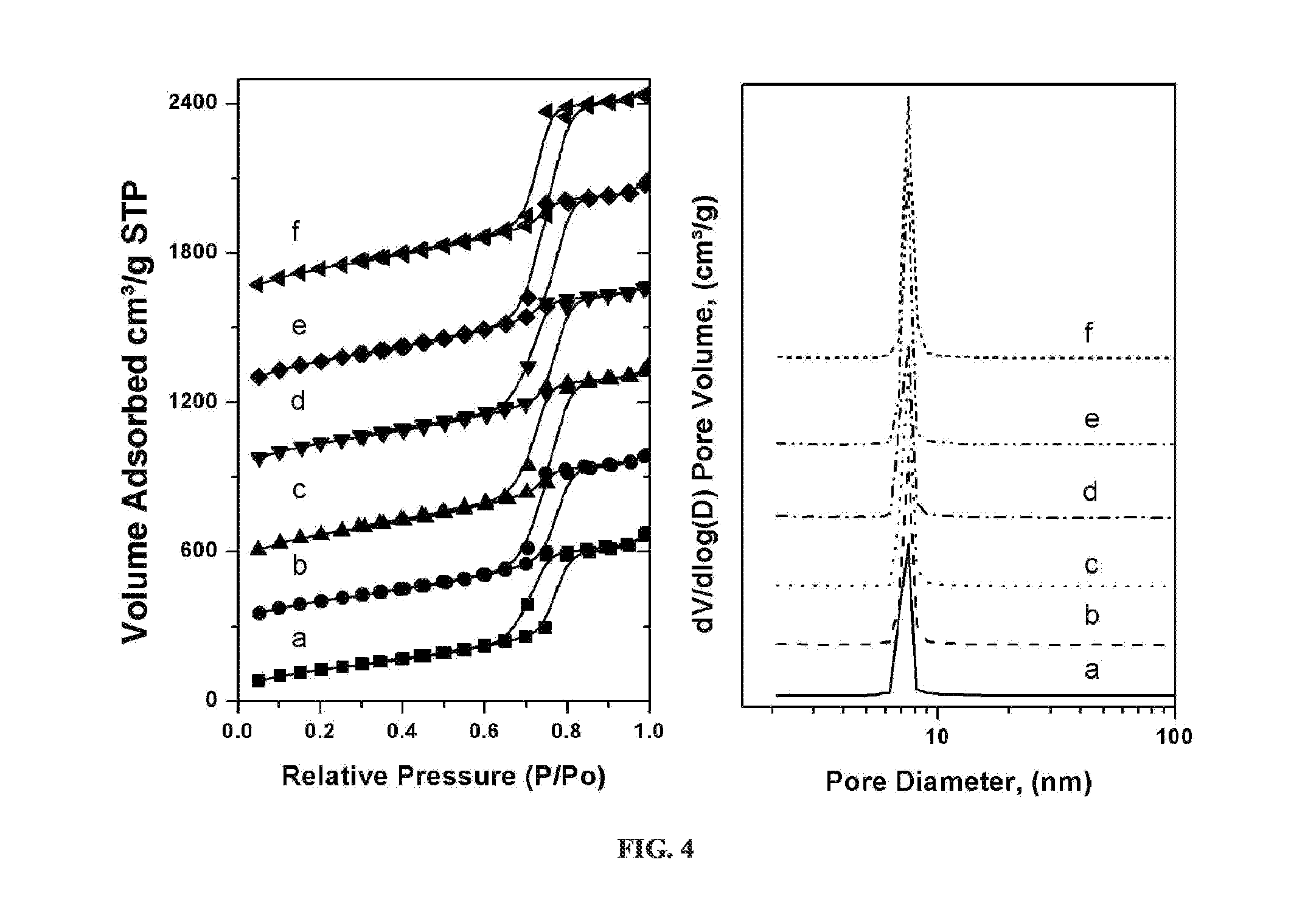Alkylene epoxidation with mesoporous catalysts
a catalyst and mesoporous technology, applied in the field of olefin epoxidation, can solve the problems of high flammability of the gaseous mixture of ethylene and eo, the burning of feedstock ethylene and product eo, and the need for additional energy-intensive steps to separate and recycle large amounts of unreacted ethylene from the product, etc., to achieve easy recovery and recyclability, reduce the carbon footprint, and low cost
- Summary
- Abstract
- Description
- Claims
- Application Information
AI Technical Summary
Benefits of technology
Problems solved by technology
Method used
Image
Examples
example 1a
Synthesis of W-KIT-6
[0071]Mesoporous W-KIT-6 materials were synthesized following the procedure reported for synthesizing high quality siliceous KIT-6 material in Kim et al., MCM-48-like large mesoporous silicas with tailored pore structure: facile synthesis domain in a ternary triblock copolymer-butanol-water system, Am Chem Soc 127 7601-7610 (2005). The W-incorporated materials are denoted as W-KIT-6 (molar Si / W value). In a typical synthesis, 5.0 g of triblock copolymer Pluronic P123 (EO20-PO70-EO20, Aldrich) was dissolved in 185 mL of 0.5 M HCl solution at 35° C. Then 5.0 g of n-butanol (Aldrich) were added and the stirring continued for another 60 minutes. Then 10.6 g of tetraethyl orthosilicate (TEOS, Aldrich) and required amounts of sodium tungstate (Acros Organics) were added. The resulting reaction mixture was stirred at 35° C. for 18 hours and then hydrothermally treated at 98° C. for 48 hours under static conditions in a Teflon-lined stainless steel autoclave. The solid p...
example 1b
Synthesis of W-KIT-5
[0072]The synthesis of W-KIT-5 materials was carried out following the procedure reported for synthesizing high quality siliceous KIT-5 material (see Kleitz et al., Large Cage Face-Centered-Cubic Fm3m Mesoporous Silica: Synthesis and Structure, J. Phys. Chem. B 107 14296-14300 (2003)). In a typical synthesis, 3.6 g of triblock copolymer Pluronic F127 (Sigma) were dissolved in 180 ml of 0.4 M HCl solution at 45° C. Then 16.9 g of tetraethyl orthosilicate (TEOS 98%, Aldrich) and required amounts of sodium tungstate (Acros Organics) were added. The resulting reaction mixture was stirred at 45° C. for 18 h and then hydrothermally treated at 98° C. for 24 h under static conditions in a Teflon-lined stainless steel autoclave. The solid product was filtered without washing, dried at 100° C. overnight and calcined in a flow of air at 550° C. for 5 hours. The resulting solids are denoted as W-KIT-5 (molar Si / W ratio).
example 2
Characterization of W-KIT-6
[0073]2-D SAXS patterns were collected on a Rigaku system with an S-MAX 3,000 instrument using a Bede Scientific microfocus tube source operating at 45 kV and 0.66 mA. Patterns were rotationally averaged and presented as intensity versus scattering angle. A 10×10 cm wire detector was placed approximately 150 cm from the sample position and silver behenate was used to determine the exact pixel to scattering angle conversion. Room temperature x-ray powder patterns in the high angle were obtained using monochromated CuKa radiation (λ=1.54178 Å) on a Bruker Proteum Diffraction System equipped with Helios multilayer optics, an APEX II CCD detector and a Bruker MicroStar microfocus rotating anode x-ray source operating at 45 kV and 60 mA. The powder samples were mixed with a small amount of Paratone N oil to form a paste that was then placed in a small (less than 0.5 mm) nylon kryoloop and mounted on a goniometer head. The specimen was then positioned at the gon...
PUM
| Property | Measurement | Unit |
|---|---|---|
| temperature | aaaaa | aaaaa |
| pressure | aaaaa | aaaaa |
| pore diameter | aaaaa | aaaaa |
Abstract
Description
Claims
Application Information
 Login to View More
Login to View More - R&D
- Intellectual Property
- Life Sciences
- Materials
- Tech Scout
- Unparalleled Data Quality
- Higher Quality Content
- 60% Fewer Hallucinations
Browse by: Latest US Patents, China's latest patents, Technical Efficacy Thesaurus, Application Domain, Technology Topic, Popular Technical Reports.
© 2025 PatSnap. All rights reserved.Legal|Privacy policy|Modern Slavery Act Transparency Statement|Sitemap|About US| Contact US: help@patsnap.com



